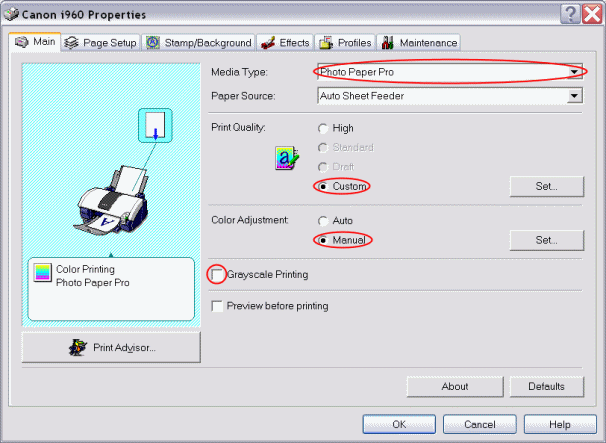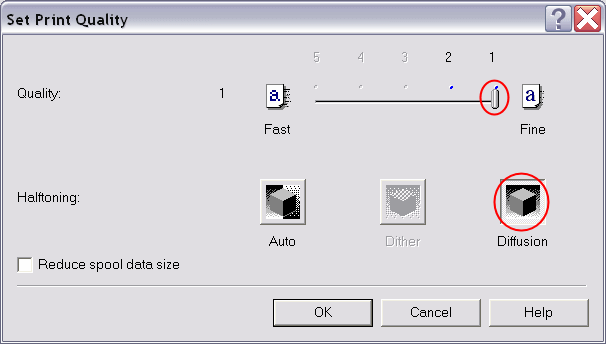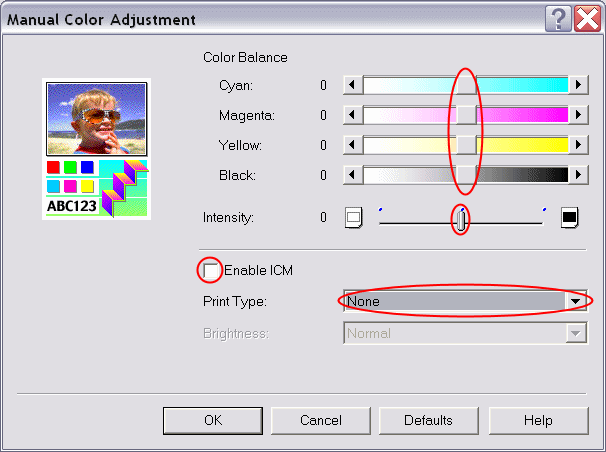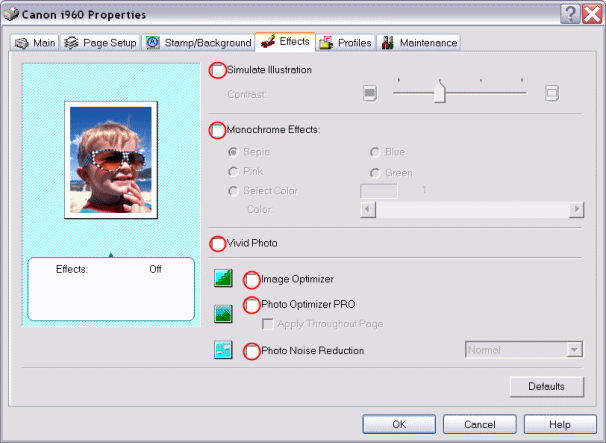Using
ICC Profiles with Canon Printers
Background
Last month we discussed how to properly utilize
ICC profiles with Epson printers. This month we focus on the use
of profiles with Canon printers. Many of the latest Canon printers
come with ICC profiles. Unfortunately, they have cryptic file
names such as CNB5CCA0.ICM and descriptions that aren't much more help
than the file name such as "Canon i960 PR1". Do you know how to
make use of these profiles or even what paper they are for? If
not, read on and we'll try to make using these profiles as simple as
possible. As we
did last month, we will assume for the purpose of this article
that you have ICC (color managed) software such as
Qimage or
PhotoShop
that you
will be using to print photos.
What is a profile?
An ICC profile is a file that
describes how to achieve accurate color on your printer
with a certain type of paper. You need to have a profile
for the specific paper (and ink) you are using. For more
information on what profiles are and how they work, read
my
August 2004 article
entitled "Over the gamut and through the woods"
.
Finding the right profile
If you have a newer model Canon
printer, it may have come with ICC profiles that
installed automatically from the software CD that comes with the
printer. The following profiles install with the Canon i960 driver for
example:
| File name |
Description |
Paper Type |
Quality Setting |
| CNB5CCA0.ICM |
Canon i960 PR1 |
Photo Paper Pro |
1 |
| CNB5CCB0.ICM |
Canon i960 PR2 |
Photo Paper Pro |
2 |
| CNB5CDA0.ICM |
Canon i960 MP1 |
Matte Photo Paper |
1 |
| CNB5CEA0.ICM |
Canon i960 SP1 |
Photo Paper Plus Glossy |
1 |
In addition to the above profiles, you may find
another more generic profile called CNBJPRN2.ICM with the description "BJ
Color Printer Profile 2000". This CNBJPRN2 profile is too generic
to be of much use and isn't a "real" printer profile, but is more of a
color matrix shaper. As such, use of this generic profile should
be avoided and profiles for specific paper/quality types should be used
like the ones above. Your Canon printer may have profiles with
slightly different names, but just remember that the description
includes the printer model followed by the paper type (PR = Photo Paper
Pro, MP = Matte Photo Paper, and SP = Photo Paper Plus Glossy), and
finally the quality setting at the end (1, 2, 3, etc.). Using the
profile description (visible in your photo editor or printing software
in the profile selection dialog), you should be able to choose the right
profile for your printer and Canon paper.
If you are unable to locate any profiles for your
printer or the paper you are using, you could try downloading and installing the latest driver for
your printer. It is possible that profiles will be installed with
the driver. To obtain the latest driver for your Canon printer, go
here and use the dropdown menus to locate your
printer. You can then download and install the driver.
If you are just not able to find
any ICC profiles on the Canon web site for your printer (or
paper that you are using), you could always create an ICC
profile yourself using a tool like
Profile
Prism, but the intent of this article
is to illustrate how to use readily available profiles
for Canon paper.
Finding the WRONG profile!
Please remember that printer
profiles are designed for a specific printer, a specific
paper type, and specific print driver settings. Don't try
to use a profile designed for Canon Photo Paper Pro with a different brand paper for example. The paper
may look the same and people may think it behaves the
same way in your printer, but you will likely be wasting
your time and ink since profiles only work with one type
of paper. Similarly, profiles for a previous (older)
model printer will likely not work properly either since
the printer hardware is probably slightly different and
the driver may be slightly different as well.
General overview of using
printer profiles
Let's assume you have located the
profile for your printer and paper. There are two steps
in using the profile and if both steps are not performed
correctly, you can end up with horrible color in your
prints (most often either green/yellow color cast or dull/dark/muddy
prints).
Let's look at the two steps to properly utilizing a
profile below.
Step 1: Print driver setup
First we have to set all print
driver settings to those required by the profile. Print
driver setup is usually accessed via "File",
"Printer Setup" or by clicking "File",
"Print" and selecting "Properties"
for your printer. A profile will only work with one
specific set of driver parameters. If you choose any
parameter incorrectly such as selecting the wrong paper
type, wrong quality setting, selecting "Vivid Photo" from the
"Effects" tab,
etc. the profile will not work properly. If the profile
you are using came with a "readme" file, be
sure to view the contents of that file and set the driver
settings accordingly. If there is no readme file that
outlines driver settings (there rarely is), you may have to rely on the
file name. You need to know the printer model, the type
of paper, and the printing mode (quality setting) as a
minimum.
Let's use the Canon i960 and Photo Paper Pro as an example. The
i960 driver CD
installs several profiles, one of which is "Canon i960 PR1". By the
description, we can tell that
this is the profile for the i960 printer with Photo Paper Pro and is designed to be used with the
driver set to quality level 1.
The following driver settings are appropriate for use with this profile:

Once the "Custom" and "Manual" radio buttons have
been checked above and the "Grayscale Printing" checkbox UNchecked, click the
first "Set" button on the right of the window under "Print Quality".
The following window will appear:

Slide the Quality slider to the right so that it
rests under the "1" for quality. Click the "Diffusion" button next
to Halftoning and click "OK" to accept. Now back on the main
driver window (first window above) click the second "Set" button under
"Color Adjustment". The following window will appear:

Make sure that the "Intensity" slider and all
four color sliders are set to zero (center position), UNcheck the
"Enable ICM" check box and set "Print Type" to "None". Click "OK"
to accept. Now back on the main driver window, click the "Effects"
tab at the top. The following window will appear:

On the "Effects" window, be sure to UNcheck all
check boxes so that no effects are selected. Click "OK" to accept
these settings, return to the main driver window, and click "OK" to
accept all the settings on all of the above windows.
Your
Canon driver screens may look a bit different than the
above i960 driver screens, but most Canon drivers are very similar.
Step 2: Select the profile
in your printing software
Now that we have opened our print
driver setup window and have selected all the proper
parameters in the driver itself, we must make the proper
selections in our printing software to tell that software
which profile to use. Step 1 of the process (above)
simply prepares the driver to accept profiled data. It is
in step 2 that our printing software must apply the
profile. To do this, we need only tell our printing
software which profile to use by giving it the file name.
Refer to the steps below to see how to perform steps 1
and 2 in Qimage and PhotoShop.
Workflow for Qimage and
PhotoShop
Qimage:
Step 1 (from above):
In Qimage,
click "File", "Printer Setup"
from the main menu.
Select your
printer and click "Properties" for
that printer.
Follow the
screens from step 1 above to set the print
driver settings.
Step 2 (from above):
Click "Settings"
from the main menu and then "Color
Management".
Click the
"Enabled" box under "Printer"
toward the middle of the window.
Click the
browse "..." button in the "Printer"
group.
Click the
"All Windows Profiles" on the lower
right of the window.
Scroll
through the list and double click on the
proper profile (for example "Canon i960 PR1").
Leave
rendering intent set to "Perceptual"
with "Black Point Compensation"
checked.
Click "OK".
Add photos to
the queue and print.
PhotoShop:
Step 1 (from above):
In PhotoShop
CS, click "File", "Print with
Preview" from the main menu. In prior
versions of PhotoShop, click "File",
"Print Options".
Click "Page
Setup".
Click "Printer"
at the bottom of the window.
Select your
printer and click "Properties" for
that printer.
Follow the
screens from step 1 above to set the print
driver settings and click "OK" to
return to the "Print with Preview"
window.
Step 2 (from above):
Back on the
"Print with Preview" window, check
"Show More Options".
Drop down and
select "Color Management".
Under "Print
Space" at the bottom, drop down "Profile"
and select the proper profile (for example
"Canon i960 PR1").
Set "Intent"
to "Perceptual" and check "Use
black point compensation".
Click the
"Print" button and print your photo.
Once step 1 and 2 have been
performed you can print any photos you like and they will
all be profiled using the printer profile you selected in
step 2. Note that Qimage remembers all software and print
driver settings even if you exit Qimage and come back
later, so step 1 and 2 will only have to be performed
once and will only need to be redone if you change print
driver settings for some other purpose/profile. PhotoShop
will not remember your settings so you'll need to redo
both steps above each time you print or save your
settings from the print driver window if your driver has
that option.
Most problems with using profiles
are caused by an error in one of the two steps above:
Failure to set print
driver settings appropriately such as paper type, print
quality, and print type "none".
Forgetting to turn on the
profile in your printing software.
As long as you always insure that
the print driver settings are set properly per the readme
file that comes with the profile (or per the instructions
in step 1 if no readme is provided) and that you have
told your printing software which profile to use, you'll
get accurate color for all your photos.
Mike Chaney


 Qimage registration expired? New lifetime licenses are only $59.99!
Qimage registration expired? New lifetime licenses are only $59.99!


 Qimage registration expired? New lifetime licenses are only $59.99!
Qimage registration expired? New lifetime licenses are only $59.99!